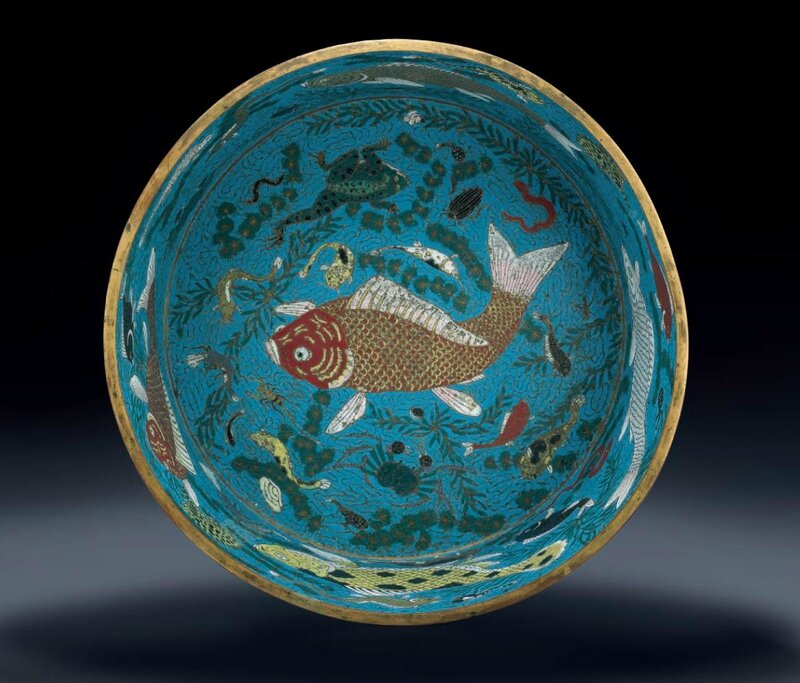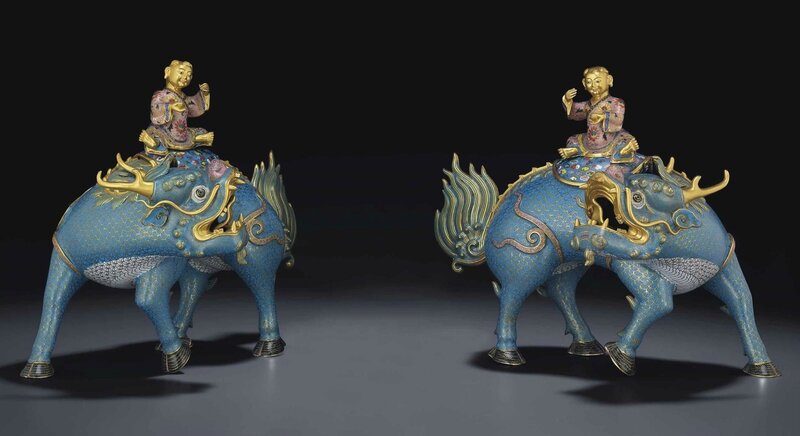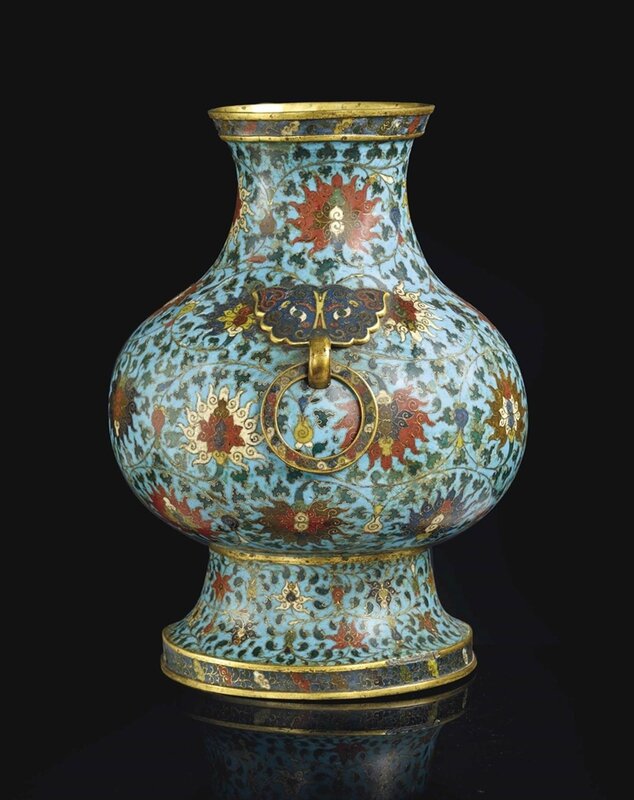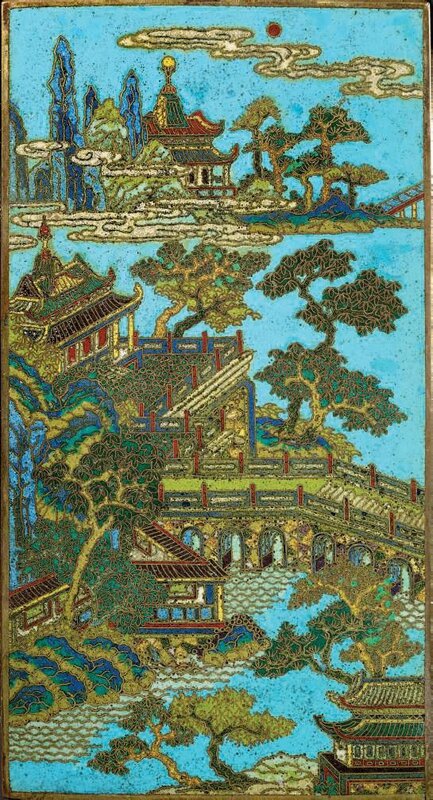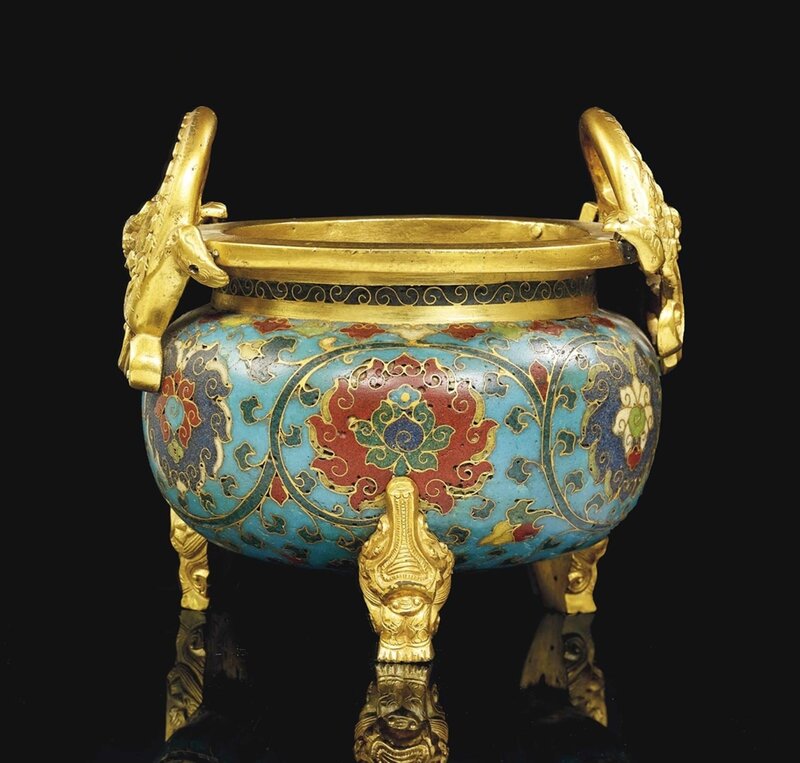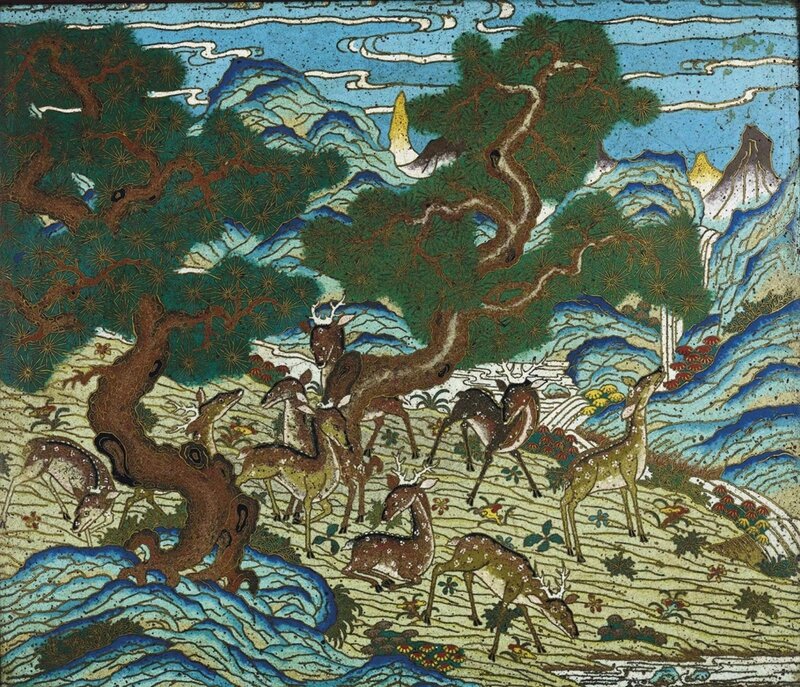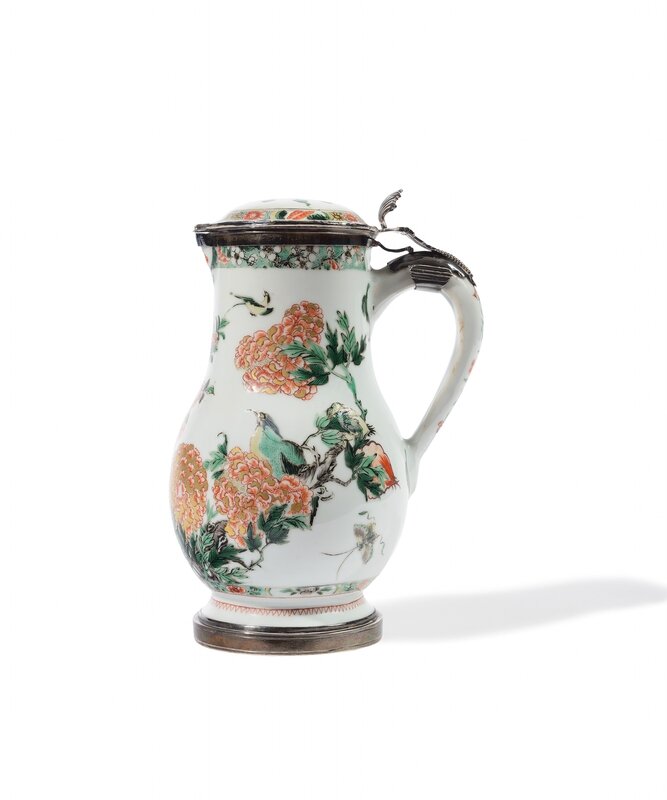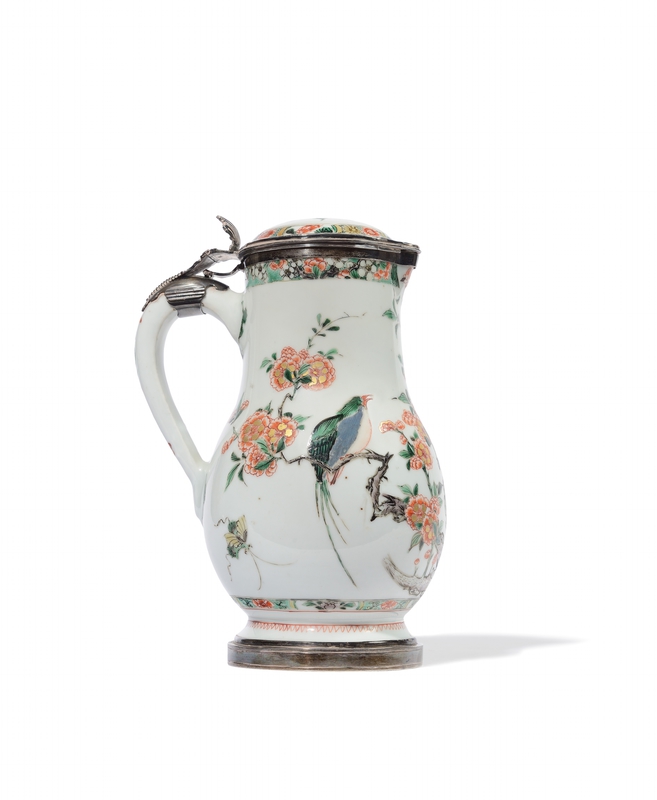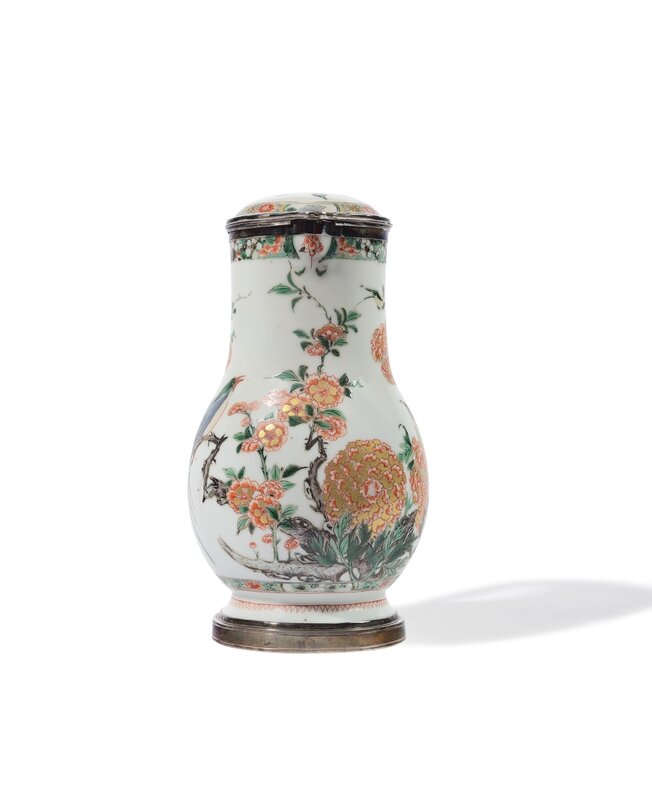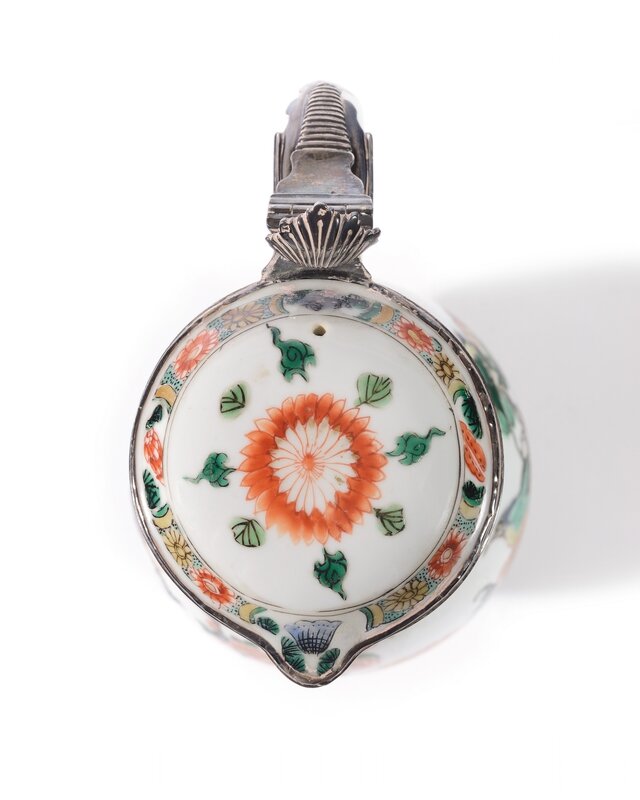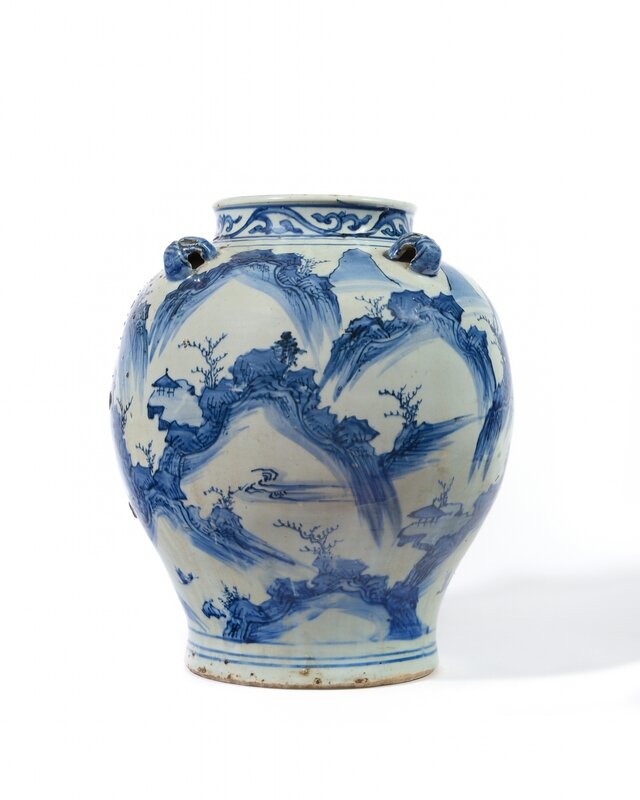![a1]()
Lot 365. Wedgwood Numbered First Edition Copy of the Portland Vase, England, 18th century. Estimate $40,000-$60,000. Photo Skinner
MARLBOROUGH, MASS.- Skinner, Inc. will present a summer auction of European Furniture & Decorative Arts in its Marlborough Gallery on Friday, July 15 at 10AM. With over 750 lots on offer, the auction will feature Part II of the Troy Dawson Chappell Collection of 17th and 18th century English Pottery and Part I of the Paul Lauer Collection of Wedgwood, as well as an expansive selection of fine silver and European fine and decorative arts of the 16th through early 20th centuries.
First Edition Portland Vase
The standout lot of the auction is a Wedgwood numbered first edition copy of the Portland Vase from the Paul Lauer Collection (Lot 365, $40,000-$60,000). Wedgwood’s oven book records list forty-three of these “first edition” vases fired between 1791 and 1796. Eleven were broken during the process, and the numbers of additional faulty vases are not known. It’s generally believed that somewhere around thirty of these black jasper vases were of first quality. Most, if not all, of these remaining vases bear a number inside the rim inscribed with manganese pencil. Paul Lauer purchased the number 22 first edition Portland vase at Sotheby & Co., London as Lot 112 of the Oster Collection catalog, November 30, 1971.
![a2]()
![a3]()
Lot 365. Wedgwood Numbered First Edition Copy of the Portland Vase, England, 18th century. Estimate $40,000-$60,000. Photo Skinner
solid black body with applied white classical figures in relief enhanced with a gray wash, a man wearing a Phrygian cap beneath the base, numbered in pencil "22" to the inside rim, unmarked, ht. 9 7/8; together with an oval solid black trial medallion with applied white foliage, impressed3, lg. 2 3/8 in. One applied cherub with loss to toes. Otherwise in very good condition throughout with no evidence of any cracks, chips or restorations.
Provenance: From the Estate of Paul Lauer. Purchased at Sotheby & Co., London as Lot 112 of the Oster Collection catalog, November 30, 1971. As noted in that catalog: exhibited at the Royal Ontario Museum of Archaeology, Toronto, Canada, 1951-53. This is the Beaufort-Codrington copy. The Dowager Duchess of Beaufort is mentioned in Byerley's pocket book among those who has subscribed for a copy of the Portland Vase, but there is a note 'Copy not received up to 1799'. It must therefore have been delivered between then and her death in 1831. The vase probably entered the Codrington family of Dodington Park, Gloucestershire when the Dowager Duchess of Beaufort's great grand-daughter, Lady Georgina Somerset, married Sir Christopher Codrington in 1836. It was bought by a dealer at the death of Lt. Gen. Alfred Codrington, G.C.V.O., K.C.B., in 1945. It was sold to Mr. Oster in 1953."
Provenance: From the Estate of Paul Lauer.
Literature: Wedgwood, by Robin Reilly, volume 1, illus. 1036, shows a copy from Tom Byerley's notebook from 1789 with list of subscribers clearly showing an entree for Dowager Duchess of Beaufort.
Fine Silver
The day opens with over 200 lots of fine silver, featuring numerous lots from the Estate of Hugh Trumbull Adams to benefit The Colonial Williamsburg Foundation. Highlights from the Estate are exemplified by a magnificent pair of George III sauce tureens by Benjamin Smith II & Benjamin Smith III modeled after the Warwick Vase (Lot 34, estimated between $8,000 and $12,000), as well as a pair of French silver-gilt chargers bearing the coat of arms of Prince Camillo Borghese and Pauline Bonaparte (Lot 58, $1,000-$1,500).
![1]()
![2]()
![3]()
![4]()
Lot 43. Pair of George III Sterling Silver Sauce Tureens, London, 1817-18, Benjamin Smith II & Benjamin Smith III, maker. Estimate:$8,000 - $12,000. Photo Skinner
one liner and tureen numbered "4," lid numbered "4" and "3(8)"; the other cover and liner numbered "2," tureen numbered "3(8)," each modeled after the Warwick Vase, cover topped with a lion-form finial and with engraved armorial to either side, the tureens also with the engraved armorial to either side of foot, lg. handle to handle 8 3/4, approx. 155.5 troy oz., with later ebonized plinth, total ht. 13 3/4 in.
Provenance: The Estate of Hugh Trumbull Adams to benefit the Colonial Williamsburg Foundation Collections Acquisitions Fund.
N.B. The coat of arms is that of the Peel family. Two sauce tureens from the same service sold at Sotheby's New York, Sale N09208, Lot 459.
![2]()
Lot 58. Two French Empire .950 Silver-gilt Chargers, Paris, 1809-19, Martin-Guillaume Biennais, maker. Estimate:$1,000 - $1,500. Photo Skinner
circular, with anthemion border and engraved coat of arms, dia. 12 in., approx. 66.7 troy oz.
Provenance: The Estate of Hugh Trumbull Adams to benefit the Colonial Williamsburg Foundation Collections Acquisitions Fund.
N.B. The plates appear to be part of the Borghese service, bearing the coat of arms of Prince Camillo Borghese (1775-1832) and Pauline Bonaparte (1780-1825). The original service comprising around 500 pieces was primarily supplied by Martin-Guillaume Biennais (1764-1843), who was the goldsmith to the Imperial Court and official supplier to the Garde-meuble under Napoleon.
Other silver highlights consist of several early British tankards, including a Charles II example from 1667-68 (Lot 1, $3,000-$5,000). Russian silver is also well-represented and led by an impressive kovsh by the 11th Artel (Lot 93, $10,000-$15,000).
![3]()
![4]()
![4-1]()
![4-2]()
Lot 1. Charles II Sterling Silver Tankard, London, 1667-68. Estimate:$3,000 - $5,000. Photo Skinner
maker's mark conjoined "WG" in a heart-form cartouche with lower pellet, marked to lid, handle, and foot, cylindrical, with slight tapering to stepped lid, a double-scroll thumbpiece and the scroll handle with engraved monogram to top, also with engraved "F" to lid and monogram to underside, ht. 6 3/8 in., approx. 23.8 troy oz.
![4]()
![4-1]()
![4-2]()
![4-3]()
![4-4]()
![4-5]()
![4-6]()
![4-7]()
![4-8]()
Lot 93. Russian .875 Silver and Cloisonné Enamel Kovsh, Moscow, 1908-17, 11th Artel, maker. Estimate:$10,000 - $15,000. Photo Skinner
second Kokoshnik standard, decorated throughout in various colored and shaded enamels, the scrolled prowl offset by hardstone cabochons along the rim, engraved to three sides of base with a dated Cyrillic inscription, ht. 5 7/8, lg. 12 in., approx. 29.8 troy oz.
Offerings of American silver are particularly numerous with pieces from makers such as Gorham, Tiffany, Kirk, Allan Adler, and Reed & Barton; highlights include a pair of Ball, Black & Co. tureens most likely by John Wendt (Lot 106, $3,000-$5,000) and a Gorham Martelé Tray (Lot 135, $7,000-$9,000).
![4-1]()
![4-2]()
Lot 106. Pair of Ball, Black & Co. Sterling Silver Covered Tureens, New York, c. 1860, probably by John Wendt. Estimate:$3,000 - $5,000. Photo Skinner
each with a domed lid topped with a bull-form finial and elaborately chased with floral and foliate sprays centering a cartouche with a star within a shield to each side, the dish with an inset silver-plate liner and two handles cast as a cow's head encircled by a floral garland, ht. 9, lg. handle to handle 14 in., approx. 145.8 troy oz. (not including liners).
![4-2]()
Lot 135. Gorham Martelé .9584 Silver Tray, Providence, c. 1909. Estimate:$7,000 - $9,000. Photo Skinner
date mark "S/AB," with an undulating rim adorned with various floral sprays including roses and morning glories, lg. handle to handle 31 in., approx. 159.6 troy oz.
Fine Ceramics
The auction features two collections of English ceramics: Part II of the Troy Chappell Collection of 17th and 18th century English pottery, and Part I of the Paul Lauer Collection of Wedgwood.
The Chappell Collection is comprised of an extensive selection of tin-glazed earthenwares, white salt-glazed stonewares and lead glazed wares highlighted by a number of dated examples. Highlights include, a tin-glazed wine bottle dated 1649 (Lot 216, $7,000-$9,000), a tin-glazed punch bowl with central inscription “Success to the British Arms” (Lot 246, $2,500-$3,500), a white salt-glazed stoneware King of Prussia teapot in polychrome enamels (Lot 308, $3,000-$5,000), and a diamond-shaped solid agate teapot (Lot 337, $5,000-$7,000).
![4-3]()
Lot 216. Dated Tin-glazed Earthenware Wine Bottle, England, c. 1649, probably Southwark. Estimate:$7,000 - $9,000. Photo Skinner
globular shape with narrow neck and loop handle, allover white glazed inscribed in blue "WHIT 1649," ht. 5 in.
Provenance: From the Troy Chappell Collection; Ex collection Hodgkin; Scholes; Curtis.
Literature: Illustrated in Dated English Delftware, by Lipski and Archer, illus. 1384.
![4-4]()
![4-5]()
Lot 246. Tin-glazed Earthenware Punch Bowl, England, c. 1756-63, probably London. Estimate:$2,500 - $3,500. Photo Skinner
the exterior with blue and manganese decoration of a chinoiserie landscape with central pagoda, the interior walls with bianco-sopra-bianco-style flowers and scrolled foliage surrounding a deep blue inscription "sUcCeS tO tHe bRiTiSh ArMs," dia. 10 3/8 in.
Provenance: From the Troy Chappell Collection; Ginsburg & Levy.
Literature: Similar illustrated in British Delft at Williamsburg, by Austin, illus. 52.
![4-6]()
Lot 308. White Salt-glazed Stoneware King of Prussia Teapot and Cover, England, c. 1756-63, probably Staffordshire. Estimate:$3,000 - $5,000. Photo Skinner
globular shape with molded crabstock handle and spout, black ermine ground with polychrome enameled central reserves, one side with titled portrait depiction of "Fred III Prufsiae Rex," the reverse with Prussian eagle bearing a ribbon inscribed "Semper Sublimis," ht. 4 1/4 in.
Provenance: From the Troy Chappell Collection; Jonathan Horne.
Literature: Identical illustrated in British Teapots & Tea Drinking, by Emmerson, illus. 14.
![4-7]()
Lot 337. Agate Diamond-shaped Teapot and Cover, England, c. 1745-50, probably Staffordshire. Estimate:$5,000 - $7,000. Photo Skinner
foo lion finial, deep cream ground with rust-brown clay, ht. 5 3/4 in. Covr: Rim chips professionally restored. Pot: Slight nicks to top rim and spout
Provenance: From the Troy Chappell Collection; Jonathan Horne.
Literature: Illustrated in Ceramics in America-2003, The Chipstone Foundation, p. 108, figs. 63-64.
In addition to the first edition Portland Vase, highlights of the Paul Lauer Collection include, a black jasper dip Apotheosis of Virgil vase and cover (Lot 392, $5,000-$7,000), and a monumental Adams dark blue jasper dip vase with cover and pedestal (Lot 418, $3,000-$5,000.) Several other Portland vases in a variety of colors and bodies are also included, as are a number of large plaques in both jasper and black basalt.
![4-8]()
![4-9]()
Lot 392. Wedgwood Black Jasper Dip Apotheosis of Virgil Vase and Cover, England, 19th century. Estimate:$5,000 - $7,000. Photo Skinner
Medusa masks, the bulbous body with classical figures, the cylindrical drum base with fruiting grapevine festoons terminating at lion masks with ribbons and trophy drops, impressed mark, ht. 28 in. 1/2" chip to inner collar of cover. Socle restored; footrim of drum base with small chip.
Provenance: From the Estate of Paul Lauer.
![4-10]()
![4-11]()
Lot 418. Monumental Adams Dark Blue Jasper Dip Vase, Cover, and Pedestal Base, England, 19th century. Estimate:$3,000 - $5,000. Photo Skinner
acorn finial to a domed cover, heavily decorated in high white relief with oak leaf and acorn borders and festoons, goat head handles, overall ht. 50 1/2 in. Scattered chips to leaves and acorns.
Provenance: From the Estate of Paul Lauer.
Works by Emile Lessore were a favorite of Mr. Lauer, and his collection includes several plaques, oil paintings and watercolors executed by the 19th century artist, as well as a grouping of table wares. The collection is diverse and includes several black basalt portrait busts, a nice assortment of majolica in Wedgwood and Minton, as well as carrara and Minton parian groups. Also offered will be a fine selection of Mettlach pottery including table wares and several large plaques; a pair of phanolith plaques with mythological figures in relief (Lot 478, $1,200-$1,800); as well as a nice selection of Sarreguemines majolica including a “Coupe Sandier”(Lot 484, $3,000-$5,000), and Lot 489, a pair of covered floor vases on pedestal bases ($4,000-$6,000). Part II of the Lauer Collection will be offered as part of our European Furniture & Decorative Arts auction on October 7.
![4-12]()
![4-13]()
Lot 478. Pair of Mettlach Circular Phanolith Plaques, Germany, early 20th century. Estimate:$1,200 - $1,800. Photo Skinner
each pale green ground with white mythological figures in relief, the central figures riding a dolphin, numbered "7040," signed "Stahl," and "7043," impressed marks, dia. 21 in.; set in modern frames. Light scuff marks; no evidence of any cracks, chips or restoration.
Provenance: From the Estate of Paul Lauer.
![4-14]()
![4-15]()
Lot 484. Sarreguemines Majolica Coupe Sandier, France, late 19th century. Estimate:$3,000 - $5,000. Photo Skinner
designed by Alexandre Sandier, allover aegean blue ground with gilding, the large bowl molded with classical children amongst chain festoons terminating at ribbon ties, the complimenting pedestal similarly decorated and with a central urn framed within three caryatid supports set on a radiating circular base, inscribed "ALEX. SANDIER," impressed factory mark, bowl dia. 29, overall ht. 47 1/2 in. The bowl has been heavily restored throughout.
Note: For an identical vase see Christie's London, The Opulent Eye, Sale 1554, Lot 14, September 18, 2014.
Provenance: From the Estate of Paul Lauer.
![4-15]()
Lot 489. Pair of Sarreguemines Majolica Covered Floor Urns, France, 19th century. Estimate:$4,000 - $6,000. Photo Skinner
each deep blue ground with ribbed body, each panel with a string of foliage and with stiff leaves surrounding foot rim, set atop a complimenting raised pedestal with matching cover, overall ht. 74 in. Cover: One with rim chips professionally restored. One cover in good condition. Urns: One with old 1 1/2" chip repair at shoulder; spotty glaze loss surounding shoulder. One urn in good overall condition. Pedestals: each with surface abrasions to glaze; one with a repair to a top corner.
Provenance: From the Estate of Paul Lauer.
Rounding out the offerings of English ceramics are select additions which include three Doulton Lambeth George Tinworth decorated terra cotta plaques (Lots 504-506, $2,000-4,000), a pearlware bear-form teapot (Lot 493, $1,000-2,000), a variety of Wedgwood including two tri-color jasper prunus vases (Lot 498 and 499, each $1,000-$1,500), a pair of Worcester porcelain fan pattern fruit coolers (Lot 494, $800-$1,200), and a Nottinghamshire brown salt-glazed stoneware loving cup dated 1756 (Lot 490, $1,000-$2,000).
![4-16]()
Lot 504. Doulton Lambeth George Tinworth Decorated Terra-cotta Plaque, England, c. 1878. Estimate:$2,000 - $4,000. Photo Skinner
rectangular, modeled in high relief with depiction of "THE FINDING OF MOSES," inscribed above "AND PHAROAH DAUGHTER SAID UNTO HER, TAKE THIS CHILD AWAY AND NURSE IT FOR ME AND I WILL GIVE THE THEY WAGES," and below "H. DOULTON & CO LAMBETH" and "G. TINWORTH" and monogram, 6 x 13 in.; set in an ebonized wood frame. By sight, 3/8" edge flake to right side. Not examined out of frame.
Provenance: The Fine Art Society, London.
![4-17]()
Lot 506. Doulton Lambeth George Tinworth Decorated Terra-cotta Plaque, England, c. 1878. Estimate:$2,000 - $4,000. Photo Skinner
rectangular, modeled in high relief with depiction of "PETER PAYING THE TRIBUTE MONEY" inscribed above, with "A PRUDENT MAN FORSEETH THE EVIL AND HIDETH HIMSELF" below "EGYPTIANS ASSAYING TO DO THE WORLD WERE DROWNED" and "H. DOULTON & CO LAMBETH AND G. TINWORTH" and monogram, 6 x 13 in.; set in an ebonized wood frame. No evidence of any cracks, chips or restoration. Not examined out of frame.
Provenance: The Fine Art Society, London
![4-18]()
Lot 493. Staffordshire Pearlware Bear Teapot and Cover, England, c. 1810. Estimate:$1,000 - $2,000. Photo Skinner
enamel decorated in brown and green, the seated figure modeled holding a hound-form spout, the head modeled as the cover, ht. 8 in. Cover: restoration to rim; 2" hairline to snout (noticeable from the inside only). Slight scattered edge flakes. Pot: In overall very good condition.
![4-19]()
Lot 494. Pair of Worcester Porcelain Fan Pattern Fruit Coolers, England, c. 1800. Estimate:$800 - $1,200. Photo Skinner
twig-form handle to cover, foliate decorated handles to pot, gilded and polychrome enamel decorated fan designs in alternating colors with a variety of gilded patterns bordering central orbs gilded with stars, inscribed "B" mark, ht. 11 1/4 in. Missing insert liners. One in very good condition wiyth but a slight rim chip along the inner edge of the top rim of the cooler. One with staple repair to an extensive hairline along one side of the body running roughly 4 1/2" down from top rim and 6" across lower body.
![4-20]()
Lot 490. Nottinghamshire Brown Salt-glazed Stoneware Loving Cup, England, 1756. Estimate:$1,000 - $2,000. Photo Skinner
reeded ear-form handles to a bell shape with rouletted band to waist, inscribed on one side "Sarah Cufsens 1756," the reverse with flowers, ht. 5 3/4 in. Top rim with four rim chips, each roughly 1/4" and a small rim flake.
European Furniture & Decorative Arts
Offerings featured in the general section of the auction include numerous deaccessioned items from Colonial Williamsburg from which the proceeds will be used by the Colonial Williamsburg Foundation, exclusively for the acquisition of art and antiques to be exhibited in its art museums and historic buildings. Highlights from this collection include a rare brass Flintlock Alarm Candle Clock, with movement signed “Vincent Des Combes, Schleswig,” c. 1745, (Lot 547, $20,000-$40,000), and a selection of over ten lots of English pewter.
![4-21]()
![4-22]()
![4-23]()
![4-24]()
![4-25]()
![4-26]()
![4-27]()
![4-28]()
![4-29]()
![4-30]()
![4-31]()
![4-32]()
Lot 547. Flintlock Alarm Candle Clock, c. 1745. Estimate:$20,000 - $40,000. Photo Skinner
brass, crown wheel and verge escapement, chain drive fusee movement with alarm signed "V Des Combes Schleswig," with pierced balance bridge and silvered regulator dial, watch with roman numeral champleve dial with arcaded chapter ring, blued steel beetle and poker hands, encased in a rectangular box incscribed "Vincent Des Combes," with sides and top engraved with foliate leaf and scroll motifs, top with three divided sections, one of which contains a flintlock mechanism; the right side of the box contains a compartment covered by a hinged lid with decorated cartouche, a folding brass candle socket, and an additional lidded compartment to contain the watch key and a small pair of steel tongs; left side of the case composed of a square compartment with hinged lid, the corners of cast gilt fretwork, ht. 1 3/8, wd. 5 3/8, dp. 3 in.
Provenance: Proceeds from the sale of the collections will be used by the Colonial Williamsburg Foundation, Williamsburg, Virginia, exclusively for the acquisition of art and antiques to be exhibited in its art museums and historic buildings.
N.B. This rare clock has only a small number of other known comparable counterparts; one is part of the collection of Snowshill Manor and Garden in Gloucestershire, dated c. 1740-1745, made of brass and inscribed "Pierre Morier London."
Other highlights include a fantastic Art Nouveau bronze lamp by François-Raoul Larche of Loïe Fuller, the celebrated dancer, bearing Soit Decauville foundry mark, numbered "S771" and signed "RAOUL LARCHE," (Lot 651, $25,000-$35,000); an elegant Pair of Victorian Elkington & Co. Champlevé and silver-gilt tazza, mid to late 19th century, attributed to Auguste-Adolphe Willms, (Lot 597, $3,000-$5,000); Two Aubusson Verdure Tapestries, 19th century (Lot 699, $4,000-$6,000); a Bronze Huntsman on Horseback After Pierre Jules Mêne (Lot 741, $5,000-$7,000) and a selection of English and Continental porcelains.
![4-22]()
![4-23]()
![4-24]()
![4-25]()
![4-26]()
Lot 651. François-Raoul Larche (French, 1860-1912), Loïe Fuller. Estimate:$25,000 - $35,000. Photo Skinner.
the art nouveau bronze lamp cast as the celebrated dancer within swirling drapery, electrified, bearing Soit Decauville foundry mark, numbered "S771" and signed "RAOUL LARCHE," ht. 18 1/4 in.
Furniture highlights include a Pair of Marble Female Nude Figures with Putti, signed “Prof. Chiurazzi,” (Lot 687, $12,000-$18,000), a stunning Late Victorian Steinway Marquetry Model B Piano, signed “Cottier & Co. Designers/New York/Steinway & Sons Makers”, c. 1890 (Lot 512, $10,000-$20,000); a group of handsome Dutch marquetry cabinets (Lots 543, 705, 714, $1,000-$6,000); and a selection of Biedermeier and Biedermeier-style pieces.





































































